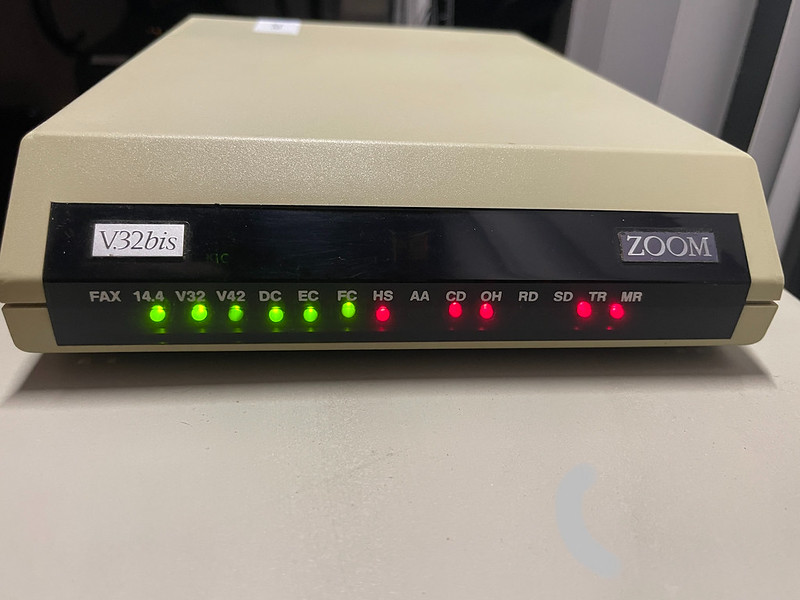Around 1995 I had a Zoom VFX V.32bis 14.4k modem as my main workhorse. It was a white plastic shell with a smoky brown translucent front face. I decided to buy one recently for old times sake:
I also came into possession of a Telebit Netblazer PN (which I need to finish working on and write up about it), which lead me to searching for manuals and more information about it. I stumbled across this eBay listing for a Telebit Teleblazer:
It’s the exact same case! Back, front, shell, underneath, face, font of the V.32bis / V.34 badge, it’s all the same! In one photo of I think the box it mentioned being based on a Rockwell chipset too. Previous Telebit modems such as the Txxxx series, Worldblazer, all had their own blocky look. At first I thought the seller had the wrong modem, but after looking at the pictures it’s very much a Telebit branded product with “Telebit TeleBlazer” on the bottom. Funnily there was one auction for $250 and another for $18 for the same kind of TeleBlazer.
This lead me to do even more digging. My Zoom VFX V.32bis was made by Zoom Telephonics Inc in 1991-1992 or so. It’s based on the Rockwell RC144DP data pump. There’s also another VFX V.32bis with a different solid, slant-front, white case that came out later I think because it was used in their later 28.8k, 33.6k and 56k models. I’ve only seen the translucent brown plastic case on VFX 14.4k modems, never anything newer.
Telebit was well renown for producing modems with fast transfers ahead of their time using their own modulation system and throwing a Motorola 68000 at it for processing oomph. The Netblazer I have has a modem chip produced by AT&T. Apparently around 1993 Telebit was trying to put out a V.34 modem like everyone else and just decided to buy Octocom Systems, who was developing their own V.34 modem. Telebit also wanted to put out their own low-cost V.34 modem to compete, so I’m guessing that’s probably how they wound up using a Rockwell chipset.
What’s interesting is that Zoom Telephonics Inc was based in Boston, MA in 1992. Octocom Systems was based in Wilmington, MA, about 15 miles outside of Boston. Did proximity have anything to do with this case story? Were there ex-Zoom employees who went over to Octocom and took their case design with them? Did Zoom sell a bunch of pallets of leftover cases to Ocotocom or Telebit? Did Zoom and Telebit share the same ODM and Telebit said gimme the cheapest case you got and ship it?
I never did find any interesting stories or gossip to explain why they used the same case. I’d also be curious to tear open a Telebit TeleBlazer to see if it even uses something like the Rockwell RC288 datapump, which everyone seemed to be using by then. But I’m not $40 curious to buy one. Further, if their V.34 modems are based Rockwell chip, is there any Telebit magic left in there, or it just a Telebit sticker on the box?
Also, I’m not getting any good nostalgic memories of this VFX modem I bought, it’s been a dog. In my testing it fails to connect a lot of the time and locks up. I don’t know if it’s because the components are aged or if this thing got damaged somehow. The modem speaker only has one sound, LOUD, no matter if I use ATM1L0 or ATM1L3. The owners manual for the VFX V.32bis can be found over on archive.org (ZV32BIS.ZIP), it has some interesting subtleties such as only MNP enabled out of the box and you have to go find the command to enable V.42/V.42bis/LAPM support. For whatever reason even if the connection is using MNP5, the DC/EC lights on the front don’t come on, you have to be using V.42/V.42bis before they light up. Fortunately it’s data compression is in hardware, it’s not one of those janky Rockwell RPI chipsets that required a driver to punt EC/DC off to the PC’s CPU. I had completely forgotten those cheap bastards existed.

